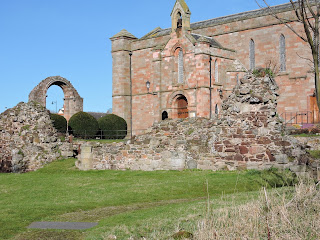 |
| Present day Priory and medieval ruins |
The results are back. Our dig in the Glebe field on the
seaward side of the Priory unearthed a huge number of animal bones: cows, deer,
sheep, pigs, even chickens. (Blog 26/06/18) Now we have
the C14 dating outcome and there is no doubt we were digging a site from the 7th
to 9th centuries, the time of the Anglo-Saxons and St Aebba.
Local tradition has it that her monastery was on the top of
the Kirk Hill, part of the massive St Abbs Head though digs there have never
unearthed any archaeological evidence.
There was an Iron Age fort there, probably the seat of the local chief
possibly Colud or one of his line.
As I said at the
meeting prior to the dig, if you want to convert people to new religion, you
don't ask them to walk four miles then climb a steep hill!
 |
| Kirk Hill - no place for a monastery |
Aebba may well have been received at the Kirk Hill fort on
her arrival as would be befitting for a Northumbrian princess and sister of the
most powerful king in the area but when it came to establishing her monastery
it would have been between the streams that run down the two sides of the
village and at the ancient pagan holy site framed by them.
The story that she was seeking sanctuary and avoiding a
forced marriage is not likely to have much substance either. If she were
escaping from the Northumbrian court, she would have had to have settled a lot
further away from the border than she did.
There must have been some conflation with a period in her early life when she did
indeed have to flee to Dal Riada in the north-west during the dynastic
struggles that resulted in the creation of Northumbria from the previous
smaller kingdoms.
She was a strong woman, the sister of two kings and would
have acted as an ambassador rather than a refugee.
Aebba's foundation was almost certainly overlaid by the
subsequent 12th and, later 14th century buildings.
We were digging in
the area beside the encompassing vallum, the perimeter dyke or ditch
that separated the sacred from the profane, the religious from the lay
communities.
After geophysics scanning, four trenches were chosen by popular
vote and we seem to have been lucky.
 |
| Trench Plan |
From the masses of
bones in one trench, we seem to have hit the monastery abattoir and thus obtained good carbon
dating material.
Hopefully funds can be found for other digs on the unexplored parts of the site.
We now have a vindication that our village is indeed the
Urbs Coludi of Bede's Historia ecclesiastica gentis Anglorum - The Ecclesiastical History of the English People.
Coludsbyrig. Colud's burgh or
town hence Coldingham in the Anglo-Saxon tongue.


No comments:
Post a Comment